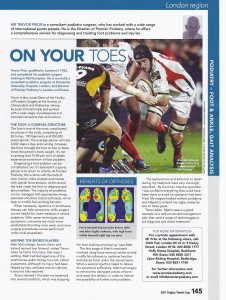There are two small bones that sit beneath the big toe joint which are called sesamoids. The sesamoids sit within one of the tendons beneath the big toe joint and help to protect the tendons during walking and to stabilise the inside of the foot as we push off into the next step. They are the foot’s equivalent to the knee cap (Patella). The top surface of the sesamoids is covered in cartilage as they form part of the big toe joint.
If there is too much pressure on the sesamoids or a direct injury then the area can become inflamed (sesamoiditis). In some instances, the cartilage on the sesamoid can be damaged and result in arthritis. It is also possible to fracture the sesamoids. If the blood supply to the bone is interrupted then this can cause an area of the bone to die and is termed avascular necrosis. Sometimes the bone can fragment or alternatively, as it heals, it becomes harder (sclerotic). In either instances, this can cause pain.

See our case history of former Ulster and Ireland rugby player Matt McCullough
What causes sesamoiditis?
Generally, a direct injury or overuse during sport causes sesamoiditis. However, patients with a low or high-arched foot or a prominent joint can be predisposed to sesamoid damage/injury. Incorrectly fitting shoes or shoes with a higher heel can all increase stress to the sesamoid area. Some patients have enlarged sesamoids which can predispose to sesamoiditis.
Will it get worse?
It is likely that sesamoiditis will get worse if the area is not protected and rested. It is not uncommon for people to ignore this problem initially only to find that it stops them walking normally, forcing them to seek treatment.
What are the common symptoms?
- Pain beneath the big toe joint
- There may be some redness and swelling beneath the big toe joint
- There may be pain and/or stiffness on moving the toe joint
- Difficulty in shoes
- Difficulty in walking
- There may be an associated deformity, especially a prominent joint.
How is it recognised?
Clinical examination and a detailed history allow diagnosis. X-rays are helpful in evaluating the sesamoids although more detailed scans (e.g. bone scan, C.T. or MRI) are often required.
What can I do to reduce the pain?
There are several things that you can do to try and relieve your symptoms:
- Wear good fitting shoes with plenty of cushioning (e.g. trainers)
- Avoid high heels
- Wear a protective pad beneath the joint
- Rest is often required
- Anti-inflammatories can be helpful although should not be taken long-term without a professional opinion
- Hot or cold packs may be helpful
- See a podiatrist
What will a podiatrist do?
If simple measures do not reduce your symptoms, there are other options:
- Advise appropriate shoes
- Advise exercises
- Consider prescribing orthotics
- Request appropriate investigations
- Administer a cortisone injection when appropriate
- Consider a period of immobilisation
- Advise on surgery
Will this cure the problem?
In many instances, the conservative measures are sufficient to resolve discomfort and allow a return to activity. However, because of the nature of the problem, this can take a few months.
What will happen if I leave this alone?
Although your symptoms may settle, it is likely they will get worse.
What happens if the symptoms do not settle?
In a small number of cases, surgery is required to resolve pain.
How does the operation solve the problem?
If the sesamoid has fractured and the fracture does not heal properly, removal of the sesamoids may be necessary. However, this can affect function of the big toe joint and needs to be considered carefully.
If the sesamoids are enlarged then they can be reduced (sesamoid planing) and this may be sufficient to relieve discomfort but avoid the need to remove the sesamoid completely.
I have heard it is very painful.
The nature of surgery means that there will be pain and swelling, usually worse the night after surgery. However, with modern anaesthetic techniques and pain killers, this can be well controlled. The level of pain experienced varies greatly from patient to patient with many experiencing no significant discomfort.
Will I have to have a general anaesthetic (be asleep)?
Not if you do not want one. Many of these procedures are performed perfectly safely under local anaesthetic (you are awake). Some patients worry that they may feel pain during the operation but it would not be possible to perform the operation if this were the case.
Will I have to stay in hospital?
No. As long as you are medically fit and have adequate home support, many patients are able to have this type of operation performed as day surgery and go home.
Will I have to have a plaster cast?
No. A plaster cast is not required for this type of surgery.
Are there a lot of complications?
There are risks and complications with all operations and these should be discussed in detail with your specialist. However, with most foot surgery it is important to remember that you may be left with some pain and stiffness. This is why it is not advisable to have surgery if the deformity is not painful and does not limit your walking. A thorough examination of your foot and general health is important so that these complications can be minimised.
Although every effort is made to reduce complications, these can occur. In addition to the general complications that can occur with foot surgery, there are some specific risks with sesamoid surgery:
- Fracture of the remaining portion of sesamoid
- Weakness and / or deformity of the big toe
- You may get discomfort in other parts of your foot during the recovery period. This generally settles.
When will I be able to walk again and wear shoes?
In the majority of cases, you will able to walk with the aid of crutches within 2-4 days but you will remain somewhat limited for the first 2 weeks. However, if the surgical incision is on the sole of the foot, you will not be able to walk on this area for 3 weeks. This is to minimise the problems with scarring as this could result in discomfort and hard skin formation for the rest of your life.
Some patients are able to return to wider shoes within 2 weeks and most are generally back into shoes by 4-6 weeks.
Swelling generally starts to reduce at 6-8 weeks and the foot will be beginning to feel more normal at 3 months although the healing process continues for 1year.
When will I be able to drive again?
When you feel able to perform an emergency stop. This is generally between 4-8 weeks post operatively but you should always check with your insurance company first.
When will I be able to return to work?
If you are able to get a lift and have a job that is not active and you can elevate your foot, you may be able to return after 1-2 weeks. Generally, patients return to work between 4-8 weeks depending on the type of job, activity levels and response to surgery.
When will I be able to return to sport?
Although the healing process continues for up to 1 year, you should be able to return to impact type activity at around 2-3 months. This will depend on the type of operation you need and how you respond to surgery.

 Call 020 8502 1777 or
Call 020 8502 1777 or  online form
online form